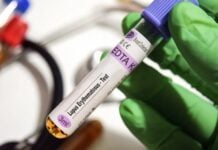Ever tried bleaching out stubborn sunscreen marks from your favorite clothes only to be met with a shocking splash of crimson? This perplexing phenomenon intrigued Professor Clare Mahon from Durham University’s Department of Chemistry, sparking an unexpected scientific investigation.
Mahon teamed up with colleagues within Durham’s ANTENNA project — a collaborative effort between the university, Procter & Gamble (P&G), and Imperial College London focused on developing cutting-edge cleaning solutions. Their mission: to unravel the chemistry behind this curious sunscreen-bleach reaction that transforms innocent white laundry into vibrant scarlet canvases.
Their research, published in the journal Chemical Communications, delved into the interaction of eleven popular commercial sunscreens with bleach. Seven out of these tested sunscreens yielded that distinct red coloration when exposed to chlorine bleach. Intriguingly, all seven contained a common ingredient: diethylaminohydroxybenzoyl hexyl benzoate (DHHB).
While earlier research had identified changes within the DHHB molecule when exposed to chlorine, this alteration wasn’t believed to produce such a strong color change, leaving scientists puzzled. Professor Mahon and her team suspected there was more to the story than met the eye.
To pinpoint exactly what happened at a molecular level, they utilized nuclear magnetic resonance (NMR) experiments in collaboration with Professors Andy Beeby and Mark Wilson, along with Dr. Alan Kenwright and Dr. Eric Hughes. Their findings revealed an unusual transformation within the DHHB molecule—a process called ipso-dichlorination. Essentially, two chlorine atoms unexpectedly attached themselves to the same location on one of the molecule’s ring structures.
This unexpected arrangement altered how the molecule interacted with light. Computational simulations by Professor Mark Wilson demonstrated that this modified DHHB absorbed most shorter and medium-wavelength visible light, allowing only longer red wavelengths to pass through – resulting in the vibrant scarlet stain witnessed firsthand on many a summer wardrobe mishap.
The good news? This discovery could potentially lead to better sunscreen formulations in the future. By modifying the DHHB molecule to resist this ipso-dichlorination, scientists hope to eliminate those unwanted red stains altogether, safeguarding our beach towels and t-shirts from becoming accidental abstract art canvases. Further research and testing are needed before such modifications reach store shelves, but the road towards stain-free summer apparel looks promising indeed.






























